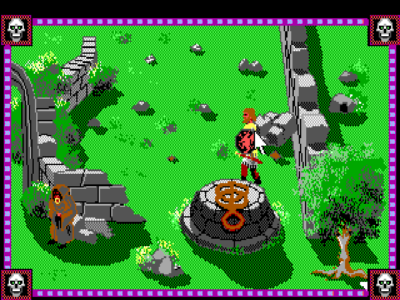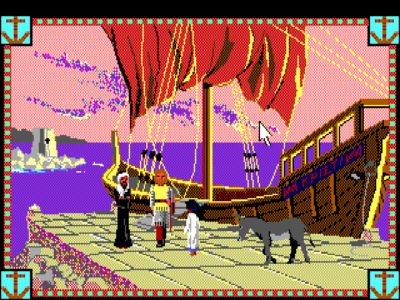
Conquests of Camelot
Written by: Stoo
Date posted: September 1, 2006
- Genre: Adventure
- Developed by: Sierra
- Published by: Sierra
- Year released: 1990
- Our score: 7
Today we’re going right back to the roots of FFG. Conquests of Camelot is one of the oldest games on the site, and also one of the first ones I wrote about when we started the project back in 2001. Back then FFG existed largely as a review counterpart to the abandonware scene, looking at the kind of early-90s titles such sites tend to feature. Nowadays we’ve broadened our scope quite a lot, looking at games down to maybe three or so years old. However I feel it’s important that we continue to look at games from the older generations, especially when they do still manage hold our interest. Once in a while I also like to re-evaluate a game; partially for the sake of seeing if I still like it as much in 2006 as I did in 2001. And partially cos my early reviews were, ahem, a bit rubbish.
All that said, despite our dedication to the games of days gone by, Rik and I can only really summon lukewarm enthusiasm for these Sierra adventures. Of course, Sierra should be respected for having invented the Graphical Adventure game, a much-loved genre which sadly died a slow death in the late 90s. It all goes back to their original King’s Quest, after all. Unfortunately though, their storytelling tended to rely too much on twee fairytale stuff, or lame attempts at humour. Solid enough fare, but eclipsed (in our opinion) by the more imaginative and wacky works of Lucasarts, or occasionally game from smaller studios like Beneath a Steel Sky.
This one, however, is the one Sierra adventure I’ve really enthusiastically enjoyed. Like many of them it’s a Quest. Well, sort of. A Conquest. Designed for Sierra by Christy Marx and husband Peter Ledger, Camelot isn’t a part of any of Sierra’s major adventure series. It did have a follow-up of sorts known as Conquests of the Longbow, although the British legends theme is about the only common factor.
It is, of course, based on tales of King Arthur. It seems the kingdom of Camelot is in trouble; a curse has fallen on the land and the people are starving. The source of that curse seems a bit vague, something to do with poor Arthur getting depressed over Gwenhyver’s affair with Launcelot. Anyway three of Arthur’s knights set off to find the holy grail with which to break the curse; they failed. Now it’s up to Arthur himself to save his land. Okay, it’s a slightly lame starting premise, a bit of a hastily-drawn up excuse to send Arthur running for the grail, but bear with me.

Amidst the long-abandoned ruins of Glastonbury Tor. I wonder what that monk is doing here.
The strength of Camelot is the real sense of atmosphere it carries, and the way its dark-ages world is brought to life on your screen. There’s a sense of a great adventure and epic questing in the dark ages. Marx seems to have done a fair bit of reading up on the legends of that period, which helps.
The first half of the game is set in England; you’ll be visiting dark and dangerous forests, a ruined monastery and the frozen domain of an angry Lady of the Lake. Later on you travel to Jerusalem; here Arthur is not a king but a traveller in a dangerous land. Despite the limits of EGA graphics, thanks to some quality artwork the game does a decent job of creating such environments; the forests are gloomy and spooky, the holy lands dusty and exotic. The music, – written by Sierra stalwart Mark Siebert, also contributes to the ambiance nicely.
The period in which the game is set is the seventh century, and some of the details are a little anachronistic – Castle Camelot itself seems like something from the late middle-ages, as does the plate-armour worn by an enemy you meet. At other times though Camelot does seem to be aiming for an earlier, post-roman setting more suitable to the time. Arthur himself, for example, is drawn like a Celtic chieftain, and Camelot’s chapel has shrines to both Christ and an old Roman God. Of course this is all based on legend, and not supposed to be a history lesson. Still, since those legends originate from centuries before the Norman Conquest, it seems suitable to me to try and base the environment on that period as much as possible.
There are also plenty of supernatural factors weaved in, like forest spirits and sorcerers. This is handled quite well; they come across more as forgotten figures of a dark and distant past, rather than fantasy nonsense. While the story of the Holy Grail is known to us mostly as a Christian legend, later in the game the narrative links it to Goddesses of the ancient world, like Aphrodite. Religion is a common theme throughout; the game depicts a time when old deities are fading, and new faiths taking their place.
Unfortunately, the game is maybe a little short. I do find that the length of adventures is maybe hard to assess, as much of the time taken is working out how to make further progress, rather than any kind of reflexes or decision-making process. So once you know all the answers, you can often rattle through in a couple of hours. Still, I’m pretty sure many other adventures give you more to do than this one. At one point it taunts you with a map full of ancient British locations, of which you can only travel to about three. Which is just annoying.
Another minor frustration is that some of the ‘puzzles’ are really just copy protection in disguise, requiring you to sift information from the manual. It’s something of a signature feature of the old Sierra adventures. Still, a couple of these are concerned with mythology of the ancient world, and if you’re vaguely knowledgeable on such subjects it’s fun to do some research yourself to tackle them. I actually blagged my way through one using my kids’ book on Greek myths and legends, and nowadays the mighty power of Google will be a great help.

Later on you voyage to the holy lands.
Aside from using your grey matter, there is a bit of fighting action also. This includes a joust, chasing a mad monk around Glastonbury Tor and a final epic swordfight. It’s not too difficult, so those of you who dislike such action interludes should manage it eventually. Just be aware that outside combat as well, there are plenty of opportunities to be killed and faced with a ‘game over, restart or reload?’ screen. Which might be unfamiliar if you’re more used to the Lucasarts games. Also brace yourself for some blood and guts on occasion – which would hardly be shocking if we were talking about Doom, but is more out of the ordinary for an adventure.
A technical detail: Camelot is powered by an early version of Sierra’s SCI interpreter, and as such is not fully point-and-click in the manner of later games. You can move and look at items with the mouse, but for most interactions you must type in commands via the text parser. The danger with an old system like this is, you might end up in a situation where you know what to do, just be unsure as to how to express the command. Fortunately it’s not too frustrating in this case.
Coming back to my original thoughts, can we honestly recommend a fifteen-year old game? Of course we’re fans of the oldies on this site. We’re not completely hopeless nostalgics though, and won’t blindly slap a seal of approval anything and everything just cos it reminds us of rainy Saturdays hunched in front of the computer when we were kids. The fact that we’re not reviewing games all the way back to the 1980s shows that a line has to be drawn somewhere, and we can’t put games for all ages on an equal footing with some magic call of ‘ignore the graphics’. Games have developed in many ways since then.
Fortunately then, good adventures can often age quite well. Especially, that is, when they give you a decent story to follow and an interesting world to interact with. In fact I can think of more adventures from the early 90s worth genuinely recommending than I can flight sims or racing games. To be honest, this one does come close to the limit of how old we’ll consider on this site. It does however manage to justify its place, providing you can live with the creaky EGA exterior. It’s a well-crafted and absorbing piece of interactive storytelling, that for me stands out from the rest of the Sierra bunch.


 Posts
Posts